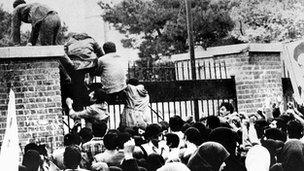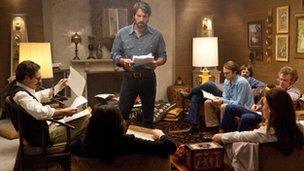Argo: The true story behind Ben Affleck's Globe-winning film
- Published

Argo recreates the storming of the US embassy in Tehran in November 1979
Ben Affleck's film Argo tells the bizarre story of how in 1980 the CIA - with Canadian help - sprang a group of Americans from Iran after they escaped a US embassy overrun by protestors.
The film, which has received seven Oscar nominations including one for best picture, is based on real-life events. But how much of it is fiction?
When Mark Lijek took Tehran as his first posting in the US foreign service, he knew he wasn't opting for an easy life.
"I was asked to volunteer in October 1978 and things in Iran were already pretty bad," he explains.
"There were violent demonstrations on the streets and it wasn't at all clear the Shah could survive. Then in January he abdicated and left the country."
Mark did a six-month course in Farsi before arriving in Iran in the summer of 1979, followed by his wife. Cora Lijek wasn't a foreign service official but was given a contract because the embassy urgently needed Farsi speakers.
The couple couldn't have guessed how quickly they would find themselves in extraordinary circumstances.
The US embassy in Tehran consisted of 26 acres surrounded by more than a mile of wall, with only 13 marines to protect it. Not long before Mark's arrival it had been overrun by anti-American protestors who had left after a few hours.
So when demonstrators again broke in, early on 4 November 1979, Mark initially assumed the same thing might happen.
"Mainly the protest was because America had chosen to admit the Shah for medical treatment. The consular building, where Cora and I worked, was at least five minutes from the main chancery building and had its own door onto the street.
"The people who broke in forgot about us or initially didn't much care."

Ben Affleck (centre) both directs and stars in Argo, which came out in the UK last year
Mark Lijek, now retired, is impressed with how Ben Affleck stages the taking of the US embassy in Argo, a sequence filmed partly in Istanbul and partly on location in California.
"It was almost the first time I'd thought deeply about what it must have been like for the 50 or so Americans in the main building," he tells the BBC. "Those scenes were quite difficult to watch."
It is after the six Americans slip away from the embassy that Argo becomes a masterclass in reshaping reality into a Hollywood hit.
The screenplay has the escapees - Mark and Cora Lijek, Bob Anders, Lee Schatz and Joe and Kathy Stafford - settling down to enforced cohabitation at the residence of the Canadian ambassador Ken Taylor.
In reality, after several nights - including one spent in the UK residential compound - the group was split between the Taylor house and the home of another Canadian official, John Sheardown.
Mark Lijek says he can see why Argo makes the switch. "That group dynamic builds the tension, I suppose, and makes it seem more dramatic when there's disagreement.
'Books and Scrabble'
"However, it's not true we could never go outside. John Sheardown's house had an interior courtyard with a garden and we could walk there freely.
"But it is true we had little to do except read books and play Scrabble. We drank quite a lot too."
The screenplay ratchets up the tension when an Iranian maid at the Canadian ambassador's residence guesses who his guests are. "Kathy Stafford, who was at the ambassador's, calls that a composite character," continues Lijek.

Mark and Cora Lijek were among the six escapees from the stormed US embassy
"I think some Iranian employees probably did work out who the Staffords were, but it was a highly theoretical risk."
The central element of the story sounds incredible but is in fact true. The CIA cooked up a plan to spirit the six out of the country on a scheduled flight from Tehran's Mehrabad airport, masquerading as Canadians working on a non-existent science-fiction film.
Mark Lijek recalls that, of the group, he was the most immediately enthusiastic. "I thought it had the right amount of pizzazz. Who but film-makers would be crazy enough to come to Tehran in the middle of a revolution? I had no problem pretending to be in the movie industry."
The truth - which Argo artfully obscures - is that the cover story was never tested and in some ways proved irrelevant to the escape.
There is a sequence in the film where the six go on a location scout in Tehran to create the impression they are movie people. According to Mark, the scene is total fiction.
"We could never have done that. Our story was to be that the Canadian ambassador had strongly advised us not to scout for locations because of instability on the streets.
Phoney documents
"If asked, we were going to say we were leaving Iran to return when it was safer. But no one ever asked!"
In retrospect, Mark Lijek thinks the value of the cover story was to give the escapees the confidence to get through the ordeal at the airport.
Argo's final scenes are superbly tense, as the six make it onto the plane by the skin of their teeth. The CIA had given them false departure documents for which, of course, there were no matching arrival forms.
The big climax is a heart-pounding chase down the runway as gun-toting members of the Revolutionary Guard try to stop them taking off.

Actresses Kerry Bishe and Clea DuVall play Kathy Stafford and Cora Lijek in the film
"Absolutely none of that happened," says Mark.
"It's true there could have been problems with documentation - it was our biggest vulnerability.
"But the Agency had done its homework and knew the Iranian border authorities habitually made no attempt to reconcile documents.
"Fortunately for us, there were very few Revolutionary Guards about. It's why we turned up for a flight at 5.30 in the morning; even they weren't zealous enough to be there that early.
"The truth is the immigration officers barely looked at us and we were processed out in the regular way. We got on the flight to Zurich and then we were taken to the US ambassador's residence in Berne. It was that straightforward."
The six were meant to live in Florida under assumed names until the release of other embassy personnel held hostage in Tehran, which came in January 1981. But the plan was dropped when reports of the escape appeared in newspapers.
In 1981, a TV movie called Escape from Iran: The Canadian Caper told the story minus the CIA's involvement. The agency didn't admit its role until 1997.
Mark says it came as a relief when he could finally talk openly about the events in Iran. He's a fan of Argo and takes a wryly amused view of how it burnishes the truth to dramatic effect.
Of course, Mark is wise to the ways of film-makers. Back in the 1980s, he was briefly in movies himself.
- Published14 January 2013
- Published11 January 2013
- Published10 January 2013